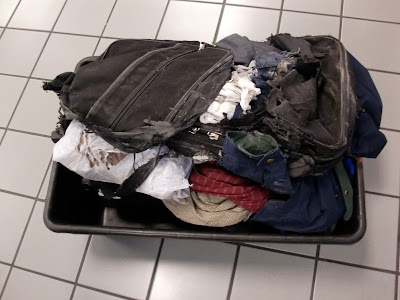October 21, 2011 -- Mom and I attended a class that Mom's nephrologist office (Dallas Nephrology Associates) provides to patients with chronic kidney disease (CKD). The first part of the class covered some basic topics such as:
- What do the kidneys do
- What causes Chronic Kidney Disease (CKD)
- What are the stages of CKD
- How is kidney function is measured (primarily by Creatinine level and GFR)
- How can you slow down the progression of CKD
- What are some symptoms of CKD
It was a lot of material but at least they gave us printouts of the PowerPoint slides.
The second part of the class covered the treatment options for kidney failure, which are:
- Kidney transplant
- Hemodialysis
- Peritoneal Dialysis
- No treatment
There wasn't much discussion of the "no treatment" option, but they went over the basics of each of the other three options, describing the process and giving the pros and cons of each one. Mom and I knew about peritoneal dialysis and had talked a little about peritoneal dialysis vs. hemodialysis before attending this class, and the class confirmed that she should opt for peritoneal dialysis if and when she gets to that point. It seems like peritoneal is much more flexible than hemodialysis, since you do it at home, it's easier to travel, and it doesn't tie you down to visiting a dialysis clinic (somewhere) three times a week. (There is a home hemodialysis option, but that requires someone to be with the patient during dialysis, which wouldn't be an option for Mom.) At this point we could only guess how long it would be before Mom needed dialysis, and her nephrologist hadn't given her any indication of when it would be. We were guessing dialysis was at least two years away.
November 3, 2011 -- You may recall from my September 13, 2011 post that I made contact with another person who has the fibrinogen mutation, who I referred to as NL from South Africa. I can now tell you that "NL" has graciously allowed me to use her full name, which is Nicola Lloyd. After Mom and I got back from Chicago I sent Nicola an email about the familial meeting, and she wrote me back with two very interesting bits of info.
- First, she was preparing to travel to London for an evaluation at the UK National Amyloidosis Centre. As far as I know that is the center of experience for amyloidosis in Europe, so it's like going to Boston or Mayo in the US.
- Second, she had used the letter I sent to Mom's cousins as a guide for writing a letter to her cousins, and she had already gotten responses from cousins in Australia and the UK. It seems there is a history of kidney problems with some of her relatives, so her communication may help some of them more quickly obtain a proper diagnosis if they have the fibrinogen mutation. Stories like that give me the warm fuzzies.
November 17, 2011 -- After returning from London Nicola sent me an email about her trip to the National Amyloidosis Centre. Highlights of that email were:
- They can do a full-body scan for amyloidosis there called an SAP scan, which gives a graphical representation of where amyloid deposits are in the body. Based partly on the results of that scan, her amyloidosis does appear to have been detected early. Good news there.
- The doctors at the UK National Amyloidosis Centre (NAC) are not quite sold on the idea of doing liver only transplants for patients with fibrinogen amyloidosis. Recall that Cathy Tidwell had a liver transplant in 2010 at UCSF. I found out later that the doctors at the NAC were unaware of that until they heard it from Nicola, and they were interested in contacting Cathy to find out more details.
- Remember our CPHPC update in October of 2010? Well, as of November of 2011, CPHPC had been used in 30 patients with all types of amyloidosis. [Link to journal article is here.] The results have been good and show the amyloid deposits being reduced. (I assume that is determined primarily by the SAP scan mentioned above.) Supposedly this initial trial will last another six months. The doctors indicated that Nicola might be a candidate for the next round of clinical trials with CPHPC.
Next up: Looking for a liver
[Edited January 12, 2013: Added link to journal article in last paragraph.]

